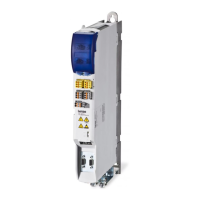Troubleshooting and fault elimination
10.2 Fault analysis with the history buffer
10-4
L
EDSVS9332S-E EN 3.0
10.2.1 Structure of the history buffer
z The history buffer has eight memory locations. The fields below ”Fault history” indicate the
memory locations 2 to 7.
z The fields below ”Actual fault” show the memory location 1. This location contains information
about the active fault.
– The entry in the memory location 2 is only done when the active fault is not present anymore
or has been acknowledged. With this entry, the last fault drops out of the history buffer and
cannot be called anymore.
z The history buffer contains three information items for every fault occurred:
cde
c Fault recognition and reaction
d Time of the fault
e Frequency of the fault
The following table shows the assignment of information and codes.
Code and information to be retrieved Memory location
C0168 C0169 C0170 Subcode
1
Active fault
2
Memory location 1
3
Memory location 2
F
equency o
he immedia
ely
4
Memory location 3
Faul
ecogni
ion and
eac
ion Time o
he las
occu
ence
following occurrence
5
Memory location 4
6
Memory location 5
7
Memory location 6
8
Memory location 7
10.2.2 Working with the history buffer
cde
g
f

